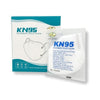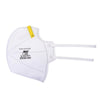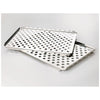- No products in the cart.
Fuming nitric acid is a highly corrosive and reactive chemical, known for its strong oxidizing properties and ability to nitrate organic compounds. It is widely used in various industrial and research applications, including the production of explosives, rocket propellants, and in chemical synthesis. Two of the most commonly used concentrations of fuming nitric acid are 90% and 98%. While both are highly concentrated and hazardous, they differ in their chemical properties, reactivity, and suitability for specific applications. Understanding these differences is crucial for selecting the right concentration for your needs.
Understanding Fuming Nitric Acid
Before diving into the differences between 90% and 98% fuming nitric acid, it’s important to have a basic understanding of what fuming nitric acid is. It is essentially nitric acid (HNO₃) that contains dissolved nitrogen dioxide (NO₂), giving it a characteristic reddish-brown color and a sharp, pungent odor. The term "fuming" refers to the release of nitrogen dioxide fumes, which is more pronounced at higher concentrations. These fumes are not only highly toxic but also contribute to the acid’s aggressive oxidizing behavior.
Composition and Properties
The primary difference between 90% and 98% fuming nitric acid lies in their concentration of nitric acid and the amount of dissolved nitrogen dioxide.
-
90% Fuming Nitric Acid: This concentration typically contains 90% nitric acid and approximately 10% nitrogen dioxide and water. It is slightly less reactive compared to 98% fuming nitric acid and produces fewer nitrogen dioxide fumes. However, it is still highly corrosive and requires careful handling.
-
98% Fuming Nitric Acid: This concentration contains about 98% nitric acid, with only 2% being water and nitrogen dioxide. It is much more aggressive and reactive than the 90% variant, making it suitable for more demanding applications. The high concentration of nitric acid also means that it releases more nitrogen dioxide fumes, posing a greater risk to health and safety.
Reactivity and Applications
The concentration of fuming nitric acid significantly affects its reactivity and suitability for different applications.
-
Chemical Synthesis:
- 90% Fuming Nitric Acid: This concentration is often used for nitration reactions where a slightly lower reactivity is desired to control the reaction rate and prevent unwanted side reactions. It is also preferred for oxidizing organic compounds in a more controlled manner.
- 98% Fuming Nitric Acid: Due to its higher reactivity, 98% fuming nitric acid is ideal for more aggressive nitration reactions. It is commonly used in the synthesis of high-energy materials, such as explosives and rocket propellants, where a higher concentration of nitric acid is required to achieve the desired chemical transformations.
-
Materials Testing:
- 90% Fuming Nitric Acid: In materials testing, especially in metallurgical analysis, 90% fuming nitric acid is used to etch metals and reveal microstructures. Its slightly lower concentration allows for a more controlled etching process, reducing the risk of over-etching and damage to the sample.
- 98% Fuming Nitric Acid: This concentration is used when a more aggressive etching action is needed, such as in the analysis of harder or more resistant materials. The higher concentration provides a stronger oxidizing effect, making it suitable for applications where rapid material removal is required.
-
Environmental Considerations:
- 90% Fuming Nitric Acid: Due to its lower concentration, 90% fuming nitric acid poses a slightly reduced environmental risk compared to its 98% counterpart. It releases fewer nitrogen dioxide fumes, which are harmful to both the environment and human health. However, it is still a hazardous substance that requires careful disposal and handling.
- 98% Fuming Nitric Acid: The high concentration of nitric acid in this variant makes it a more potent environmental hazard. It releases more nitrogen dioxide fumes, which contribute to air pollution and can have detrimental effects on respiratory health. Proper ventilation, containment, and disposal are essential when using this concentration.
Choosing the Right Concentration
Selecting the appropriate concentration of fuming nitric acid depends on several factors, including the specific application, desired reactivity, safety considerations, and regulatory requirements.
-
Application Requirements: Consider the chemical reactivity required for your application. For controlled nitration or oxidation reactions, 90% fuming nitric acid is often sufficient. However, for more aggressive or high-energy processes, 98% fuming nitric acid may be necessary.
-
Safety Concerns: Both concentrations are highly hazardous, but 98% fuming nitric acid poses a greater risk due to its higher reactivity and increased fuming. Ensure that you have appropriate safety measures in place, including proper personal protective equipment (PPE), fume hoods, and emergency protocols.
-
Environmental and Regulatory Compliance: Check local regulations regarding the use and disposal of fuming nitric acid. In some cases, using a lower concentration like 90% may be preferred to minimize environmental impact and meet compliance standards.
-
Cost and Availability: The cost and availability of 90% vs. 98% fuming nitric acid may also influence your decision. Higher concentrations are generally more expensive and may require additional storage and handling considerations.
Safety and Handling
Regardless of the concentration, fuming nitric acid must be handled with extreme care. It can cause severe burns, respiratory damage, and environmental harm. Always use appropriate PPE, including gloves, goggles, and acid-resistant clothing. Ensure that the workspace is well-ventilated, and have spill containment and neutralization materials readily available.
Conclusion
Choosing between 90% and 98% fuming nitric acid depends on your specific needs and the nature of your application. While both concentrations offer powerful oxidizing capabilities, their differences in reactivity, safety, and environmental impact make it essential to select the right one for your purposes. By understanding these differences and taking proper safety measures, you can effectively and safely use fuming nitric acid in your projects.
For over 45 years, Lab Pro Inc. is your steadfast source for acids, lab chemicals, premium cleanroom wipes, hand tools, lab equipment, and PPE apparel. Trusted by aerospace industries, medical device companies, and laboratories globally, we epitomize exceptional quality in every product. Experience the convenience of next day service in California. Contact us online or at 888-452-2776 to explore solutions tailor-made for the laboratory industry. Elevate your experiments with Lab Pro Inc. – your partner in precision and excellence.












































